Related Research Articles

Fujitsu Limited is a Japanese multinational information and communications technology equipment and services corporation, established in 1935 and headquartered in Tokyo. It is the world's sixth-largest IT services provider by annual revenue, and the largest in Japan, in 2021. The hardware offerings from Fujitsu are mainly of personal and enterprise computing products, including x86, SPARC and mainframe compatible server products, although the corporation and its subsidiaries also offer a diversity of products and services in the areas of data storage, telecommunications, advanced microelectronics, and air conditioning. It has approximately 126,400 employees and its products and services are available in approximately 180 countries.
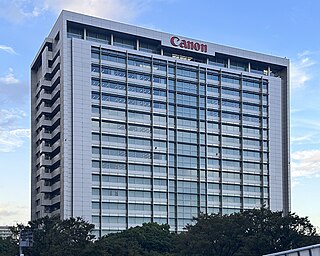
Canon Inc. is a Japanese multinational corporation headquartered in Ōta, Tokyo, specializing in optical, imaging, and industrial products, such as lenses, cameras, medical equipment, scanners, printers, and semiconductor manufacturing equipment.

The ImageWriter is a product line of dot matrix printers formerly manufactured by Apple Computer, Inc., and designed then to be compatible with their entire line of computers. There were three different models introduced over time, which were popular mostly among Apple II and Macintosh owners.

An image scanner—often abbreviated to just scanner—is a device that optically scans images, printed text, handwriting or an object and converts it to a digital image. Commonly used in offices are variations of the desktop flatbed scanner where the document is placed on a glass window for scanning. Hand-held scanners, where the device is moved by hand, have evolved from text scanning "wands" to 3D scanners used for industrial design, reverse engineering, test and measurement, orthotics, gaming and other applications. Mechanically driven scanners that move the document are typically used for large-format documents, where a flatbed design would be impractical.
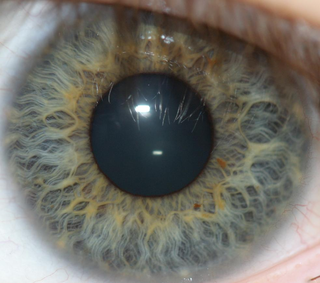
Iris recognition is an automated method of biometric identification that uses mathematical pattern-recognition techniques on video images of one or both of the irises of an individual's eyes, whose complex patterns are unique, stable, and can be seen from some distance. The discriminating powers of all biometric technologies depend on the amount of entropy they are able to encode and use in matching. Iris recognition is exceptional in this regard, enabling the avoidance of "collisions" even in cross-comparisons across massive populations. Its major limitation is that image acquisition from distances greater than a meter or two, or without cooperation, can be very difficult. However, the technology is in development and iris recognition can be accomplished from even up to 10 meters away or in a live camera feed.

A graphics processing unit (GPU) is a specialized electronic circuit initially designed to accelerate computer graphics and image processing. After their initial design, GPUs were found to be useful for non-graphic calculations involving embarrassingly parallel problems due to their parallel structure. Other non-graphical uses include the training of neural networks and cryptocurrency mining.

UMAX Technologies, originally known as UMAX Computer Corporation, is a manufacturer of computer products, including scanners, mice, and flash drives, based in Taiwan. The company also uses the Yamada and Vaova brand names.
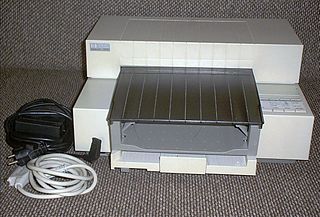
Deskjet is a brand name for inkjet printers manufactured by Hewlett-Packard. These printers range from small domestic to large industrial models, although the largest models in the range have generally been dubbed DesignJet. The Macintosh-compatible equivalent was branded as the Deskwriter and competed with Apple's StyleWriter, and the all-in-one equivalent is called OfficeJet.
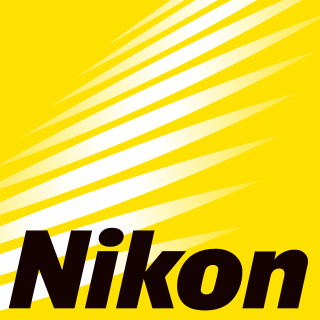
Nikon Corporation, also known just as Nikon, is a Japanese multinational corporation headquartered in Tokyo, Japan; it specializes in creating and marketing optics and imaging products. The companies held by Nikon form the Nikon Group.
Uniden Holdings Corporation is a Japanese company in the wireless communication industry.
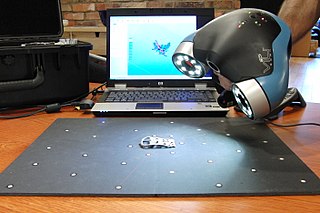
3D scanning is the process of analyzing a real-world object or environment to collect three dimensional data of its shape and possibly its appearance. The collected data can then be used to construct digital 3D models.

Book scanning or book digitization is the process of converting physical books and magazines into digital media such as images, electronic text, or electronic books (e-books) by using an image scanner. Large scale book scanning projects have made many books available online.

Forensic footwear evidence can be used in legal proceedings to help prove that a shoe was at a crime scene. Footwear evidence is often the most abundant form of evidence at a crime scene and in some cases can prove to be as specific as a fingerprint. Initially investigators will look to identify the make and model of the shoe or trainer which made an impression. This can be done visually or by comparison with evidence in a database; both methods focus heavily on pattern recognition and brand or logo marks. Information about the footwear can be gained from the analysis of wear patterns which are dependent on angle of footfall and weight distribution. Detailed examination of footwear impressions can help to link a specific piece of footwear to a footwear imprint as each shoe will have unique characteristics.
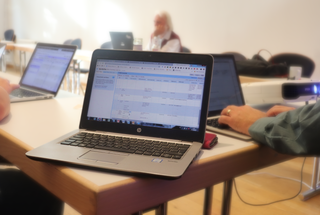
HP EliteBook is a line of business-oriented high-end notebooks and mobile workstations made by Hewlett-Packard. The EliteBook series, which fits above the lower-end ProBook series, was introduced in August 2008 as a replacement of the HP Compaq high end line of notebooks. The EliteBook brand included mobile workstations until September 2013, when they were rebranded as HP ZBook. The EliteBook mainly competes against computer lineups such as Acer's TravelMate, Dell's Latitude and Precision, Lenovo's ThinkPad and Toshiba's Portégé and Tecra.
Artec 3D is a developer and manufacturer of 3D scanning hardware and software. The company is headquartered in Luxembourg, with offices also in the United States, China (Shanghai) and Montenegro (Bar). Artec 3D's products and services are used in various industries, including engineering, healthcare, media and design, entertainment, education, fashion and historic preservation. In 2013, Artec 3D launched an automated full-body 3D scanning system, Shapify.me, that creates 3D portraits called “Shapies.”
References
- ↑ "Fujitsu scanner models list". www.scantastik.com. Retrieved 2019-08-11.
- ↑ "Now Released to Canadian Market, Fujitsu's Small Portable Scanner Does Big Job | WYT - Canadian Tech News & Tech Reviews" . Retrieved 2019-08-11.
- ↑ "New Fujitsu Scanner a Truly Portable Solution | WYT - Canadian Tech News & Tech Reviews" . Retrieved 2019-08-11.
- ↑ "ScanSnap Celebrates 5 Million Unit Shipments!". Fujitsu. 2018-11-06. Retrieved 2021-03-02.
- ↑ "S1300i_Datasheet.pdf" (PDF).
- ↑ "SV600_datasheet_v3.pdf" (PDF).
- ↑ "Fujitsu fi-7300nx Network Document Scanner". www.scantastik.com. Retrieved 2019-08-11.
- ↑ "fi-7460_datasheet.pdf" (PDF).
- ↑ "fi-7480_datasheet.pdf" (PDF).
- ↑ "fi-7600_Datasheet.pdf" (PDF).
- ↑ "Fujitsu fi-7800 scanner". www.scantastik.com. Retrieved 2019-08-11.
- ↑ "fi-7900_Datasheet.pdf" (PDF).
- ↑ "fi-7x80_datasheet.pdf" (PDF).
- ↑ "fi-7700_Datasheet.pdf" (PDF).
- ↑ "fi-7030_Datasheet.pdf" (PDF).
- ↑ "ScanSnap_iX1500_Datasheet.pdf" (PDF).
- ↑ "fi-7140_Datasheet.pdf" (PDF).
- ↑ "fi-7160_Datasheet.pdf" (PDF).
- ↑ "fi-7x80_datasheet.pdf" (PDF).
- ↑ "fi-5950_datasheet.pdf" (PDF).
- ↑ "fi-7240_Datasheet" (PDF).
- ↑ "fi-7x60_datasheet.pdf" (PDF).
- ↑ "Fujitsu ScanSnap S300 Instant PDF Sheet-Fed Scanner". Fujitsu. Retrieved 27 March 2018.
- ↑ "Fujitsu ScanSnap S300M Scanners | Portable PDF Scanners for the Macintosh". Fujitsu. Retrieved 27 March 2018.
- ↑ "Scanner model s1300 became End of Service Life in June 2017". Reddit. Retrieved 24 September 2018.
- ↑ Manjoo, Farhad (11 Jan 2012). "Everything Old Is New Again". The New York Times. Retrieved 20 March 2018.
